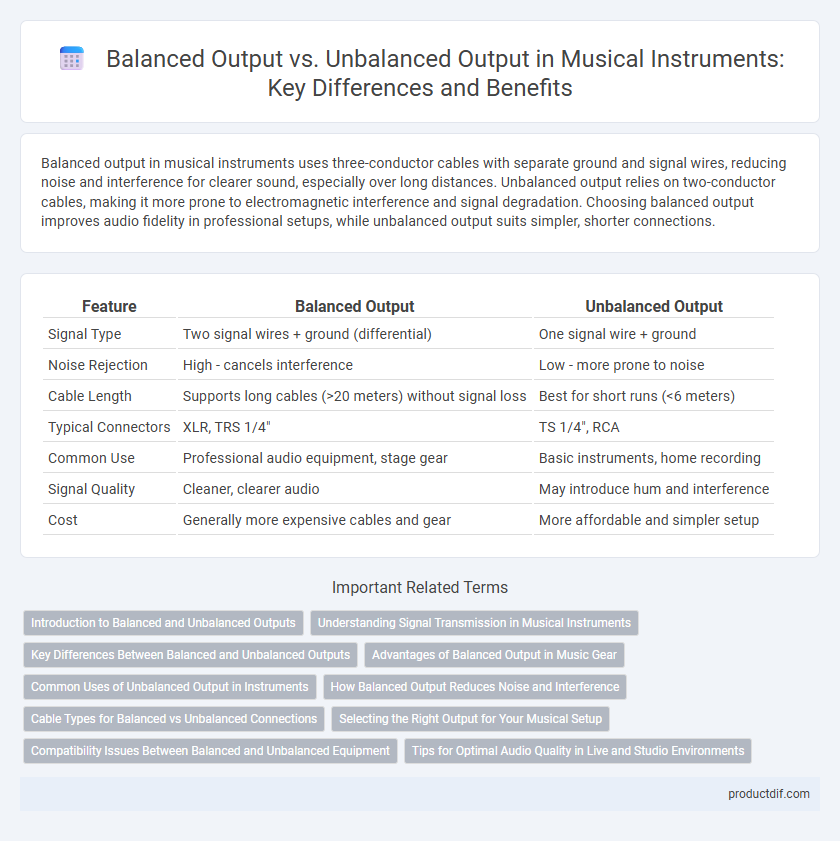Balanced output in musical instruments uses three-conductor cables with separate ground and signal wires, reducing noise and interference for clearer sound, especially over long distances. Unbalanced output relies on two-conductor cables, making it more prone to electromagnetic interference and signal degradation. Choosing balanced output improves audio fidelity in professional setups, while unbalanced output suits simpler, shorter connections.
Table of Comparison
| Feature | Balanced Output | Unbalanced Output |
|---|---|---|
| Signal Type | Two signal wires + ground (differential) | One signal wire + ground |
| Noise Rejection | High - cancels interference | Low - more prone to noise |
| Cable Length | Supports long cables (>20 meters) without signal loss | Best for short runs (<6 meters) |
| Typical Connectors | XLR, TRS 1/4" | TS 1/4", RCA |
| Common Use | Professional audio equipment, stage gear | Basic instruments, home recording |
| Signal Quality | Cleaner, clearer audio | May introduce hum and interference |
| Cost | Generally more expensive cables and gear | More affordable and simpler setup |
Introduction to Balanced and Unbalanced Outputs
Balanced outputs use three conductors--positive, negative, and ground--to reduce noise and interference, making them ideal for professional audio equipment and long cable runs. Unbalanced outputs rely on two conductors, signal and ground, which are more susceptible to signal degradation and hum, commonly found in consumer-grade instruments. Understanding the difference helps musicians and audio engineers choose the right connection type for optimal sound quality and noise rejection.
Understanding Signal Transmission in Musical Instruments
Balanced output in musical instruments uses two signal wires and a ground to reduce noise and interference during transmission, ensuring cleaner sound over longer cable runs. Unbalanced output relies on a single signal wire and ground, which is more susceptible to electromagnetic interference and signal degradation, especially with longer cables. Understanding these differences helps musicians choose the right cables and interfaces for optimal audio quality and reliable performance.
Key Differences Between Balanced and Unbalanced Outputs
Balanced outputs use three conductors--positive, negative, and ground--to reduce noise and interference, making them ideal for professional audio and long cable runs. Unbalanced outputs have two conductors--signal and ground--resulting in higher susceptibility to electromagnetic interference and shorter cable length limitations. The key difference lies in noise rejection, where balanced connections provide superior signal integrity in environments with potential interference.
Advantages of Balanced Output in Music Gear
Balanced output in music gear provides superior noise rejection by using two signal wires with opposite polarities, significantly reducing hum and electromagnetic interference. This results in clearer, cleaner audio signals, especially critical in professional recording and live sound environments. The improved signal integrity over long cable runs enhances performance and reliability compared to unbalanced output.
Common Uses of Unbalanced Output in Instruments
Unbalanced output is commonly used in electric guitars, basses, and keyboards for short cable runs to amplify sound with minimal interference. This output type relies on a single signal wire and ground, making it simple and cost-effective but more prone to noise over long distances. Typical applications include connecting directly to guitar amps, pedals, and small PA systems where signal length is limited.
How Balanced Output Reduces Noise and Interference
Balanced output uses two signal wires carrying identical audio signals with opposite polarity, which effectively cancels out electromagnetic interference and noise when combined at the receiving end. This noise reduction is achieved through common-mode rejection, making balanced connections essential for maintaining audio clarity in professional musical instruments and studio equipment. Unbalanced outputs, in contrast, are more susceptible to noise and interference due to a single signal wire and no noise-canceling mechanism.
Cable Types for Balanced vs Unbalanced Connections
Balanced outputs use cables with three conductors typically found in TRS (Tip-Ring-Sleeve) or XLR connectors, allowing for noise rejection and longer cable runs ideal for professional audio equipment. Unbalanced outputs rely on two-conductor TS (Tip-Sleeve) cables, which are more susceptible to electromagnetic interference and suitable for shorter distances commonly used in consumer or entry-level instruments. Choosing the correct cable type ensures optimal signal integrity and reduces noise, especially crucial in studio or live performance environments.
Selecting the Right Output for Your Musical Setup
Balanced output uses three-conductor cables and provides noise-free signal transmission over long distances, making it ideal for professional audio setups and connecting instruments to mixers or audio interfaces. Unbalanced output employs two-conductor cables, suitable for shorter cable runs and simpler setups, but is more prone to noise and interference. Choosing the right output depends on your musical environment, cable length, and the quality of sound you aim to achieve, with balanced outputs preferred for studio and live performances requiring clean, clear audio.
Compatibility Issues Between Balanced and Unbalanced Equipment
Balanced output uses two signal wires and a ground to minimize noise interference, while unbalanced output employs a single signal wire and ground, making it more susceptible to electromagnetic noise. Compatibility issues arise when connecting balanced outputs to unbalanced inputs, often resulting in signal loss or increased noise due to impedance mismatch and grounding differences. To avoid degradation in audio quality, musicians should use appropriate adapters or direct boxes designed to maintain signal integrity between balanced and unbalanced equipment.
Tips for Optimal Audio Quality in Live and Studio Environments
Balanced outputs utilize three-conductor cables that reduce noise and interference, making them ideal for maintaining clear audio signals in both live and studio settings. Unbalanced outputs, typically using two-conductor cables, are more susceptible to signal degradation over long distances, so keeping cable lengths short is essential for preserving sound quality. Using high-quality balanced cables and proper grounding techniques helps ensure optimal audio clarity and minimizes hum during performances and recordings.
Balanced output vs Unbalanced output Infographic

 productdif.com
productdif.com